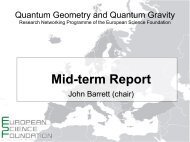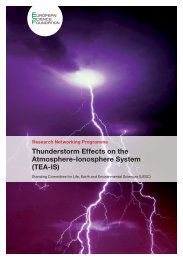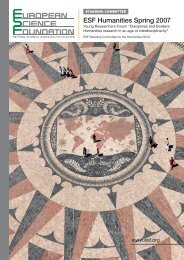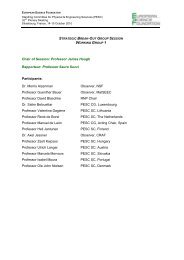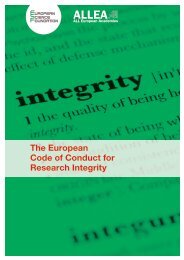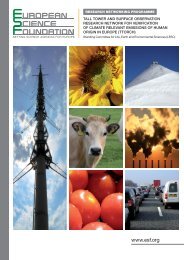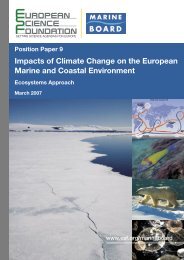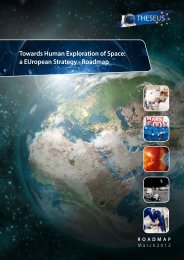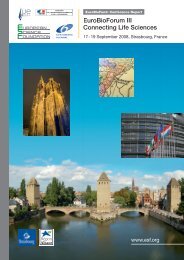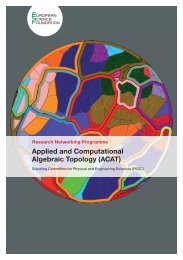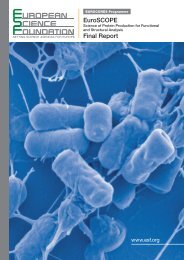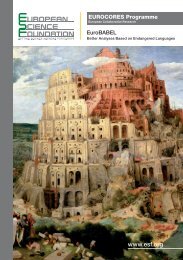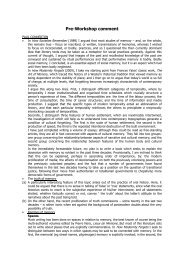European Peer Review Guide - European Science Foundation
European Peer Review Guide - European Science Foundation
European Peer Review Guide - European Science Foundation
Create successful ePaper yourself
Turn your PDF publications into a flip-book with our unique Google optimized e-Paper software.
42<br />
<strong>European</strong> <strong>Peer</strong> <strong>Review</strong> <strong>Guide</strong><br />
discipline and should include members with the<br />
relevant crossdisciplinary profiles.<br />
Recommendation<br />
Care should be taken in putting in the right<br />
context the assessments from the host and the<br />
complementing reviewers, especially when having<br />
large numbers of assessments, such that the<br />
chances of unduly penalising the proposals is<br />
minimised.<br />
Scenario B<br />
It may happen that for many of the MICT-type proposals<br />
as defined in this <strong>Guide</strong>, one host discipline<br />
may be identifiable as being the main driver for the<br />
formulation of the research objectives. However,<br />
the linkages or triggers from other disciplines in<br />
motivating the scope of the proposal are strong<br />
enough such that cross-fertilisations, innovations<br />
and new applications are probable and expected<br />
not only in the host discipline, but also to varying<br />
degrees within the other disciplines. The expected<br />
cross-fertilisation in this scenario goes beyond<br />
finding new applications in the host discipline for<br />
concepts, methods, devices and systems that are<br />
primarily conceived within one of the other disciplines.<br />
A suggested approach for <strong>Peer</strong> <strong>Review</strong><br />
Implementation in Scenario B<br />
The same general peer review approach described<br />
for Scenario A may be used for cases falling within<br />
Scenario B with the following features needing particular<br />
attention:<br />
• Stage 1: Individual assessments. To account for<br />
stronger synergy and interactions that may be<br />
present between the host and any of the complementing<br />
disciplines, and in case it is not<br />
possible to use A.1.a (i.e., matching of required<br />
research profiles to topics), it will be important to<br />
incorporate more than one assessment from the<br />
complementing discipline having strong interactions<br />
(i.e., in applying A.1.b).<br />
• Stage 2: <strong>Review</strong> panel. Similar to the first scenario,<br />
one review panel should synergise all<br />
the information and decide on ranking, prioritisation<br />
or the final decision. However, in this<br />
scenario, although the panel membership should<br />
be predominantly from the host discipline, it is<br />
recommended to include experts from the complementing<br />
disciplines with strong relevance and<br />
expectations.<br />
Scenario C<br />
In contrast to the two groups above, when dealing<br />
with some of the MICT-type and the majority<br />
of transdisciplinary proposals, it may not be possible<br />
to identify only one host discipline. In these<br />
cases, it is necessary to engage all the driving disciplinary<br />
perspectives to the same level and in the<br />
same manner within the peer review process. In this<br />
scenario the need for strong integration is present<br />
and cross-fertilisation across disciplines is expected.<br />
Successful transdisciplinary research can lead to the<br />
creation of new paradigms or disciplines.<br />
A suggested approach for <strong>Peer</strong> <strong>Review</strong><br />
Implementation in Scenario C<br />
For this scenario a three-stage process of individual<br />
assessments followed by two levels of review panel<br />
discussions may be considered. The following features<br />
are worth mentioning:<br />
a) Enough experts (ideally three) from each of the<br />
host disciplines are needed. Efforts are to be<br />
made in identifying reviewers who are familiar<br />
with pluridisciplinary research, ideally on the<br />
same topics but if not possible on closely related<br />
topics;<br />
b) One individual/remote reviewer from each of<br />
the complementary disciplines is also needed;<br />
c) <strong>Review</strong>ers from all host disciplines use the same<br />
assessment criteria while those from the complementing<br />
disciplines use a slightly different set of<br />
criteria;<br />
d) Applicants are given the opportunity to reply<br />
to the remote assessments as part of the information<br />
to be considered by the review panel<br />
meeting;<br />
e) One review panel for each host discipline is<br />
assembled to synergise individual assessments<br />
coming from that discipline plus the ones from<br />
the complementing discipline;<br />
f) As the final stage of peer review, a consolidating<br />
panel will decide on the proposal based on<br />
the recommendations of the single disciplinary<br />
panels. The members of the consolidating panel<br />
could be either completely independent or representatives<br />
of the disciplinary panels.<br />
The three suggested peer review scenarios and<br />
related specificities are summarised in Table 6<br />
below.



